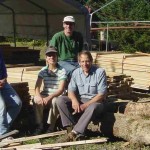Last week, I traveled to western North Carolina for a natural resources Extension conference. While there, I took a field trip to the Coweeta Hydrological Laboratory – a 5,400 acre experimental forest and the oldest continually running LTER (Long Term Ecological Research) site in the country. Coweeta is famous as the site of groundbreaking studies of how forest management and land use changes affects things like water supply and quality. It was a fascinating tour and if you have an interest in forest science, read on over the next few days as I share some of what I learned and reflect on how it relates back home in Oregon.
Many of the studies at Coweeta are set up as paired watershed studies. Two watersheds of similar size and topography are selected.  One is left as a control, and the “treatment” is applied to the other.
One is left as a control, and the “treatment” is applied to the other.
What is striking about paired watershed studies is the sheer size of the experiments. Here is a photo from a watershed at Coweeta that has been studied since the 1940’s. Back then, scientists wanted to know whether converting a mixed hardwood forest to a pine plantation would impact the water supply. So, they clearcut the treatment watershed, controlled the regrowing vegetation for a decade, and then planted it back to eastern white pine.
For the first ten years, there was more water in the stream exiting the cut watershed than in the control watershed. But, as soon as the pine was planted, water levels in the stream began to return to normal, and by the time the pines were ten years old, they were using as much water as the control forest. Ever since then, there has been significantly less water in the stream exiting the pine watershed than the hardwood watershed. Why? At the risk of oversimplification, it boils down to a few reasons: 1) pines grow (and thus use water) all through the mild Appalachian winter while the hardwoods lose their leaves and shut down; 2) pines have more foliage surface area than hardwoods, so there’s more capacity for photosynthesis (and, when trees photosynthesize they use water); and 3) pines are less efficient water users than the native hardwood species – sort of like a regular shower head compared to a low-flow one – they both get the job done, but one uses a lot more water. These were an important finding because most of the region’s drinking water originates from these mountain streams.
than hardwoods, so there’s more capacity for photosynthesis (and, when trees photosynthesize they use water); and 3) pines are less efficient water users than the native hardwood species – sort of like a regular shower head compared to a low-flow one – they both get the job done, but one uses a lot more water. These were an important finding because most of the region’s drinking water originates from these mountain streams.
We have well-known paired watershed studies in Oregon, too. Some are conducted at our “local” LTER, the H.J. Andrews Experimental Forest. Other paired watershed studies in the Coast Range at Alsea, and Hinkle Creek, and Trask have informed the development of today’s Forest Practices Act and other best forest management practices.

To learn more about the research in paired watersheds in Oregon, you can watch a videostream of a recent lecture at OSU. Also this week, as part of the Starker Lecture Series in the OSU College of Forestry, there was a field tour of the Alsea watershed studies. Unfortunately, I couldn’t make the tour. Did you go? If so, what did you learn?









